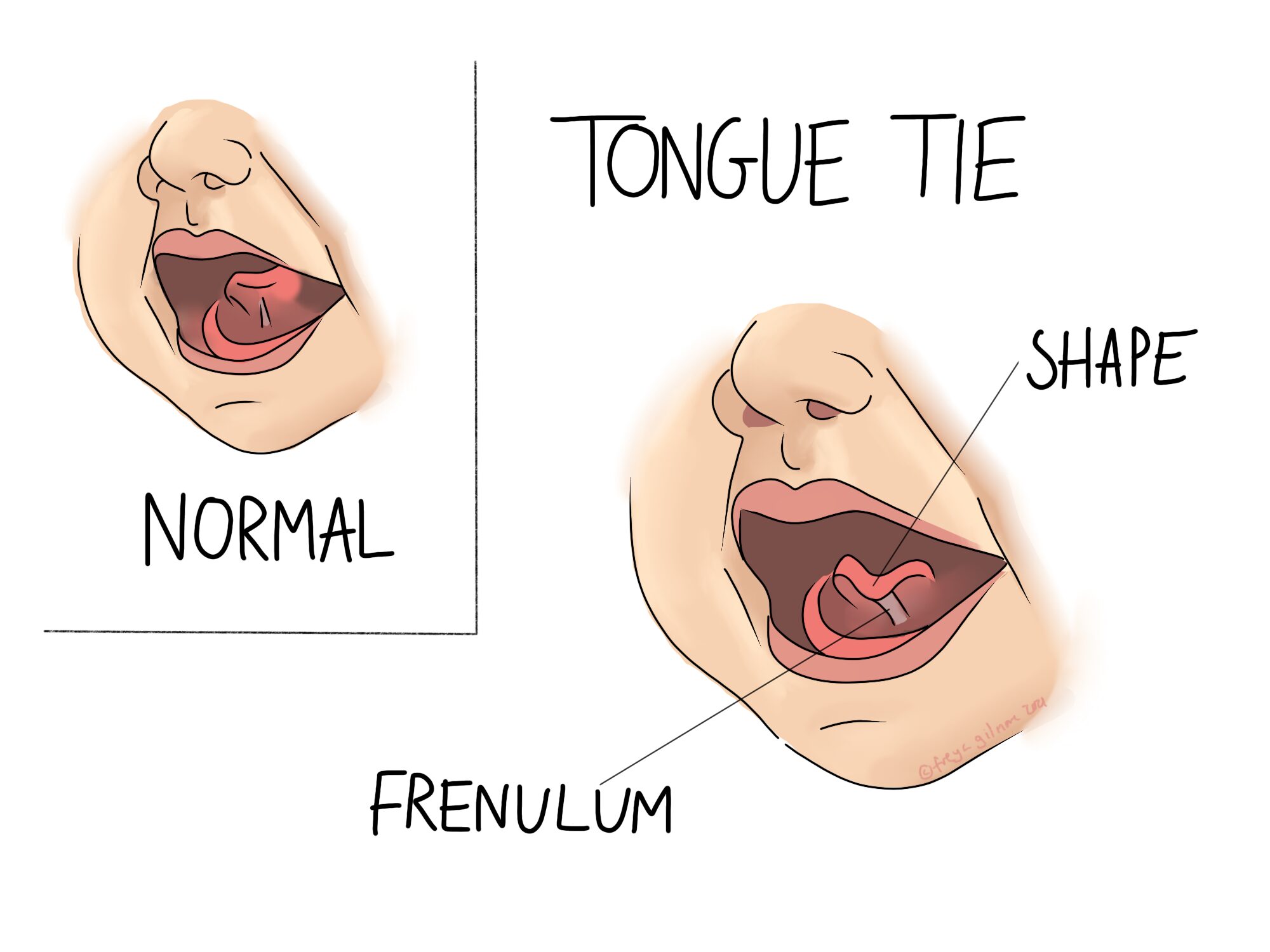Tongue-Tie: Symptoms, Causes, Treatment
What are the symptoms of tongue-tie?
Tongue-tie, or ankyloglossia, is a condition present at birth that restricts the tongue’s range of motion due to an unusually short, thick, or tight band of tissue (lingual frenulum) that tethers the bottom of the tongue to the floor of the mouth. Symptoms of tongue-tie can vary depending on the severity of the condition, but they may include:
- Difficulty sticking out the tongue: The tongue may appear notched or heart-shaped when the child tries to stick it out.
- Difficulty lifting the tongue: The child may have difficulty lifting the tip of the tongue to touch the roof of the mouth or move it from side to side.
- Difficulty breastfeeding: Infants with tongue-tie may have difficulty latching onto the breast, maintaining suction, or extracting milk effectively, which can lead to poor weight gain, fussiness during feeding, or maternal nipple pain and damage.
- Difficulty with speech: Tongue-tie can sometimes interfere with the ability to make certain sounds, such as “t,” “d,” “z,” “s,” “th,” “r,” and “l,” which can affect speech development.
- Limited tongue movement: The child may have limited movement of the tongue, which can affect their ability to clean food from the teeth or move food around the mouth.
- Difficulty with oral hygiene: Limited tongue movement can also make it difficult to keep the mouth clean, which can lead to an increased risk of tooth decay and gum disease.
It’s important to note that not all cases of tongue-tie cause symptoms, and some children may have tongue-tie without experiencing any difficulties. If you suspect that your child has tongue-tie, it’s important to consult with a healthcare provider for an evaluation and appropriate management.
What are the causes of tongue-tie?
Tongue-tie, or ankyloglossia, occurs when the lingual frenulum (the band of tissue that connects the bottom of the tongue to the floor of the mouth) is unusually short, thick, or tight, restricting the tongue’s range of motion. The exact cause of tongue-tie is not always clear, but it is thought to be due to a combination of genetic and environmental factors. Some possible causes and risk factors for tongue-tie include:
- Genetics: Tongue-tie can run in families, suggesting a genetic component to the condition.
- Fetal development: Tongue-tie may occur during fetal development when the lingual frenulum fails to fully separate from the floor of the mouth.
- Abnormalities in tissue development: In some cases, tongue-tie may be associated with abnormalities in the development of the lingual frenulum or other oral tissues.
- Environmental factors: Certain environmental factors, such as exposure to certain substances during pregnancy, may increase the risk of tongue-tie, although more research is needed in this area.
- Gender: Tongue-tie is more common in males than females, although the reason for this is not well understood.
It’s important to note that while tongue-tie may be present at birth, it may not always cause symptoms or require treatment. In some cases, tongue-tie may resolve on its own over time, especially as the child grows and the tissues in the mouth stretch and loosen. However, if tongue-tie is causing symptoms or interfering with feeding or speech development, treatment may be recommended.
What is the treatment for tongue-tie?
The treatment for tongue-tie, or ankyloglossia, depends on the severity of the condition and whether it is causing symptoms. In some cases, no treatment is needed, especially if the tongue-tie is not causing any problems. However, if tongue-tie is causing feeding difficulties, speech issues, or other problems, treatment options may include:
- Frenotomy: Frenotomy is a simple procedure to cut the lingual frenulum to release the tongue-tie. This is typically done using sterile scissors or a laser. Frenotomy is a quick procedure that can often be done in the healthcare provider’s office.
- Frenuloplasty: Frenuloplasty is a more involved procedure that may be used for severe cases of tongue-tie. It involves making an incision in the lingual frenulum and then stitching the edges to widen the opening and allow for greater tongue movement.
- Speech therapy: In some cases, speech therapy may be recommended to help improve tongue movement and function, especially if tongue-tie has affected speech development.
- Feeding support: If tongue-tie is causing feeding difficulties in infants, feeding support and guidance from a lactation consultant or healthcare provider may be helpful.
- Monitoring and follow-up: After treatment, it’s important to monitor the child’s progress and follow up with a healthcare provider as needed to ensure that the tongue-tie does not recur and that any feeding or speech issues are improving.
The decision to treat tongue-tie depends on the individual child’s symptoms and the severity of the condition. It’s important to discuss treatment options with a healthcare provider to determine the best course of action for your child.




